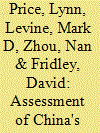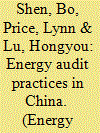|
|
|
Sort Order |
|
|
|
Items / Page
|
|
|
|
|
|
|
| Srl | Item |
| 1 |
ID:
103348


|
|
|
|
|
| Publication |
2011.
|
| Summary/Abstract |
From 1980 to 2002, China experienced a 5% average annual reduction in energy consumption per unit of gross domestic product (GDP). With a dramatic reversal of this historic relationship, energy intensity increased 5% per year during 2002-2005. China's 11th Five Year Plan (FYP) set a target of reducing energy intensity by 20% by 2010. This paper assesses selected policies and programs that China has instituted to fulfill the national goal, finding that China made substantial progress and many of the energy-efficiency programs appear to be on track to meet - or in some cases exceed - their energy-saving targets. Most of the Ten Key Projects, the Top-1000 Program, and the Small Plant Closure Program will meet or surpass the 11th FYP savings goals. China's appliance standards and labeling program has become very robust. China has greatly enhanced its enforcement of new building energy standards but energy-efficiency programs for buildings retrofits, as well as the goal of adjusting China's economic structure, are failing. It is important to maintain and strengthen the existing energy-saving policies and programs that are successful while revising programs or adding new policy mechanisms to improve the programs that are not on track to achieve the stated goals.
|
|
|
|
|
|
|
|
|
|
|
|
|
|
|
|
| 2 |
ID:
116740


|
|
|
|
|
| Publication |
2012.
|
| Summary/Abstract |
This study analyzes China's industrial energy consumption trends from 1996 to 2010 with a focus on the impact of the Top-1000 Enterprises Energy-Saving Program and the Ten Key Energy-Saving Projects. From 1996 to 2010, China's industrial energy consumption increased by 134%, even as the industrial economic energy intensity decreased by 46%. Decomposition analysis shows that the production effect was the dominant cause of the rapid growth in industrial energy consumption, while the efficiency effect was the major factor slowing the growth of industrial energy consumption. The structural effect had a relatively small and fluctuating influence. Analysis shows the strong association of industrial energy consumption with the growth of China's economy and changing energy policies. An assessment of the Top-1000 Enterprises Energy-Saving Program and the Ten Key Energy-Saving Projects indicates that the economic energy intensity of major energy-intensive industrial sub-sectors, as well as the physical energy intensity of major energy-intensive industrial products, decreased significantly during China's 11th Five Year Plan (FYP) period (2006-2010). This study also shows the importance and challenge of realizing structural change toward less energy-intensive activities in China during the 12th FYP period (2011-2015).
|
|
|
|
|
|
|
|
|
|
|
|
|
|
|
|
| 3 |
ID:
112915


|
|
|
|
|
| Publication |
2012.
|
| Summary/Abstract |
China set an ambitious goal of reducing its energy use per unit of GDP by 20% between 2006 and 2010. Much of the country's effort is focused on improving the energy efficiency of the industrial sector, which consumes about two-thirds of China's primary energy. Industrial energy audits are an important part of China's efforts to improve its energy intensity. Such audits are employed to help enterprises identify energy-efficiency improvement opportunities and serve as a means to collect critical energy-consuming information. Information about energy audit practices in China is, however, little known to the outside world. This study combines a review of China's national policies and programs on energy auditing with information collected from surveying a variety of Chinese institutions involved in energy audits. A key goal of the study is to conduct a gap analysis to identify how current practices in China related to energy auditing differ from energy auditing practices found around the world. This article presents our findings on the study of China's energy auditing practices at the national and provincial levels. It discusses key issues related to the energy audits conducted in China and offers policy recommendations that draw upon international best practices.
|
|
|
|
|
|
|
|
|
|
|
|
|
|
|
|
| 4 |
ID:
121353


|
|
|
|
|
| Publication |
2013.
|
| Summary/Abstract |
In 2010, China's cement output was 1.9 Gt, which accounted for 56% of world cement production. Total carbon dioxide (CO2) emissions from Chinese cement production could therefore exceed 1.2 Gt. The magnitude of emissions from this single industrial sector in one country underscores the need to understand the uncertainty of current estimates of cement emissions in China. This paper compares several methodologies for calculating CO2 emissions from cement production, including the three main components of emissions: direct emissions from the calcination process for clinker production, direct emissions from fossil fuel combustion and indirect emissions from electricity consumption. This paper examines in detail the differences between common methodologies for each emission component, and considers their effect on total emissions. We then evaluate the overall level of uncertainty implied by the differences among methodologies according to recommendations of the Joint Committee for Guides in Metrology. We find a relative uncertainty in China's cement-related emissions in the range of 10 to 18%. This result highlights the importance of understanding and refining methods of estimating emissions in this important industrial sector.
|
|
|
|
|
|
|
|
|
|
|
|
|
|
|
|
| 5 |
ID:
099210


|
|
|
|
|
| Publication |
2010.
|
| Summary/Abstract |
From 1970 to 2001, China was able to significantly limit energy demand growth through aggressive energy-efficiency programs. Energy use per unit of gross domestic product (GDP) declined by approximately 5% per year during this period. However, the period 2002-2005 saw energy use per unit of GDP increase an average of 3.8% per year. To stem this out-of-control growth in energy demand, in November 2005 the Chinese government enunciated a mandatory goal of 20% reduction of energy intensity between 2006 and 2010. The National People's Congress passed legislation identifying the National Reform and Development Commission as the lead agency to design and carry out programs in support of this goal. These policies and programs, created after almost a decade of decline of the energy-efficiency policy apparatus, have had considerable impact. Although initial efforts have not been sufficient to meet the annual declines required to reach the ambitious 20% energy intensity target, the latest reports indicate that China may now be on track to meet this goal. The paper provides an assessment of these policies and programs to begin to understand issues that will play a critical role in China's energy and economic future. Activities undertaken in China will have a significant influence on the global effort to reduce the growth, and later the absolute quantity, of greenhouse gas emissions.
|
|
|
|
|
|
|
|
|
|
|
|
|
|
|
|
| 6 |
ID:
113486


|
|
|
|
|
| Publication |
2012.
|
| Summary/Abstract |
This study analyzes current energy and carbon dioxide (CO2) emission trends in China's cement industry as the basis for modeling different levels of cement production and rates of efficiency improvement and carbon reduction in 2011-2030. Three cement output projections are developed based on analyses of historical production and physical and macroeconomic drivers. For each of these three production projections, energy savings and CO2 emission reduction potentials are estimated in a best practice scenario and two continuous improvement scenarios relative to a frozen scenario. The results reveal the potential for cumulative final energy savings of 27.1 to 37.5 exajoules and energy-related direct emission reductions of 3.2 to 4.4 gigatonnes in 2011-2030 under the best practice scenarios. The continuous improvement scenarios produce cumulative final energy savings of 6.0 to 18.9 exajoules and reduce CO2 emissions by 1.0 to 2.4 gigatonnes. This analysis highlights that increasing energy efficiency is the most important policy measure for reducing the cement industry's energy and emissions intensity, given the current state of the industry and the unlikelihood of significant carbon capture and storage before 2030. In addition, policies to reduce total cement production offer the most direct way of reducing total energy consumption and CO2 emissions.
|
|
|
|
|
|
|
|
|
|
|
|
|
|
|
|
| 7 |
ID:
126534


|
|
|
|
|
| Publication |
2013.
|
| Summary/Abstract |
Aims
The industrial sector dominates the China's total energy consumption, accounting for about 70% of energy use in 2010. Hence, this study aims to investigate the development path of China's industrial sector which will greatly affect future energy demand and dynamics of not only China, but the entire world.
Scope
This study analyzes energy use and the economic structure of the Chinese manufacturing sector. The retrospective (1995-2010) and prospective (2010-2020) decomposition analyses are conducted for manufacturing sectors in order to show how different factors (production growth, structural change, and energy intensity change) influenced industrial energy use trends in China over the last 15 years and how they will do so up to 2020.
Conclusions
The forward looking (prospective) decomposition analyses are conducted for three different scenarios. The scenario analysis indicates that if China wants to realize structural change in the manufacturing sector by shifting from energy-intensive and polluting industries to less energy-intensive industries, the value added average annual growth rates (AAGRs) to 2015 and 2020 should be more in line with those shown in scenario 3. The assumed value added AAGRs for scenario 3 are relatively realistic and are informed by possible growth that is foreseen for each subsector.
|
|
|
|
|
|
|
|
|
|
|
|
|
|
|
|
|
|
|
|
|